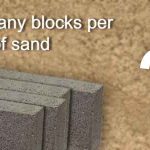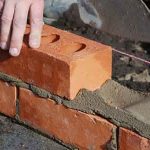One of the most important parts of building any sort of structure is to ensure you have the right base or foundations. Building a wall, a garage, internal block walls or a house is not just about putting one brick on top of the other. There’s more to the process because those blocks and bricks require a solid base to work off.
Concrete foundations, or footings as they are also known, are important when it comes to building any kind of structure. But how soon can you lay blocks on this concrete?
Once the concrete has been poured, you can usually lay blocks within 48 hours. However, this will depend on the type of concrete you use. If the foundations are relatively small and you mix the concrete yourself, there’s a chance you can lay blocks within 24 hours of pouring the concrete.
If the job is bigger and the footings or slab is larger, then the curing time will take longer. Gen 3 or ST 3 concrete is commonly used for footings, and both will cure fully after 28 days.
How Long Does Concrete Take to Dry?

Once you pour your concrete it begins to dry. This is a process that can take around 24 -48 hours. When concrete dries, the water within it evaporates through the surface. This is the reason concrete feels hard within 1-2 days of laying.
At this point, you can begin to lay blocks on it and it is even possible to walk on. Although, at this early stage you should try to avoid driving on it with any vehicles or heavy machinery.
Concrete contains around 200 litres of water per cubic metre. Not all of this water is required to keep the concrete moist but is used to improve the workability. Any water that is not needed for the chemical process will then evaporate. The general rule of thumb for drying is that it takes 30 days to fully dry for every inch of thickness.
The drying time depends on several factors. However, it’s important that concrete doesn’t dry too quickly as this can result in a weak surface. This means that you should keep it damp by placing a sheet over it. This is especially important when temperatures are above 20 degrees. In contrast, if the temperature drops below 4 degrees, then a frost blanket should be used to insulate the slab.
Moisture also plays a role in the drying process. If the concrete is exposed to excess moisture the drying process will take longer.
Concrete Curing Time Before Weight Can be Applied
Concrete might feel hard after 24 or 48 hours but that does not mean that it is ready to use. Sure, you might be able to walk on it or even lay several courses of blocks up to the damp proof course, but you should refrain from doing anything else.
The reality is, that concrete continuously cures. As time passes, concrete becomes stronger and stronger, but the majority of mixes will take around 28 days to cure. After one week, the concrete will reach around 70% of its compressive strength.
When it comes to concrete to curing, you should consider these time frames for use:
- 1-2 days – follow on work can begin up to DPC and people can walk on it.
- 7 days – concrete will be partially cured so traffic and equipment can use it
- 28 days – concrete is fully cured
Much like drying, the curing process is dependent on several factors. The process relies mostly on moisture. The more moisture in the concrete, the longer the chemical reaction will continue.
As long as there is moisture, the concrete it will continue to cure and gain strength. This makes it important to ensure that moisture is present during the curing period.
In contrast, using too much water could cause your concrete to weaken. So, what other things can affect the curing process?
- High temperatures – If the weather is hot, it could cause concrete to crack if it becomes too dry, too fast. To avoid this, the concrete should remain damp.
- Cold Temperatures – Freezing temperatures will also affect the curing process. You should make sure that the concrete does not reach freezing point within the first 48 hours. So, you should aim to insulate the concrete and keep it protected.
Conclusion
It’s important to remember that concrete must be given time to dry and cure. The two have different meanings, but once concrete is dry, it is possible to begin laying blocks up to the DPC. However, it is still not ready to accept any significant weight.
Curing is the process of concrete gaining its compressive strength. After seven days you can place some weight on it but only after 28 days is it fully cured. Therefore, it makes sense to wait for the right time to take any further action, as this could damage and weaken your concrete.




